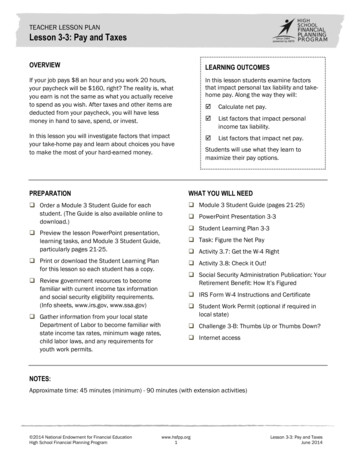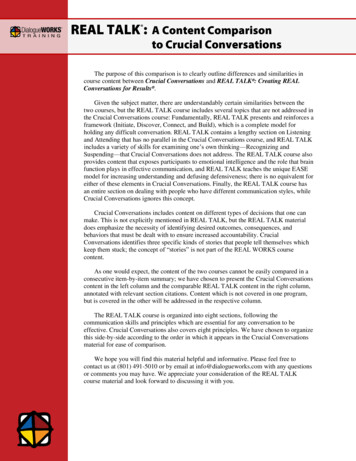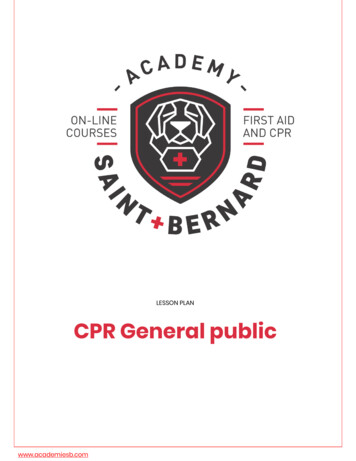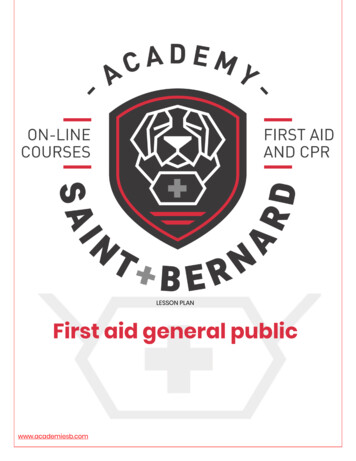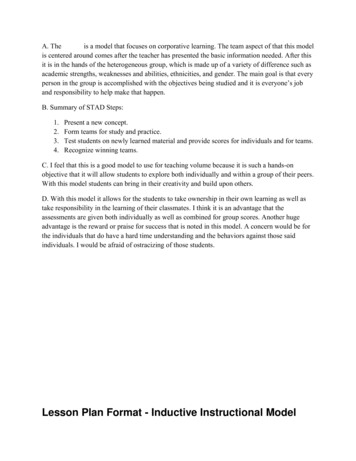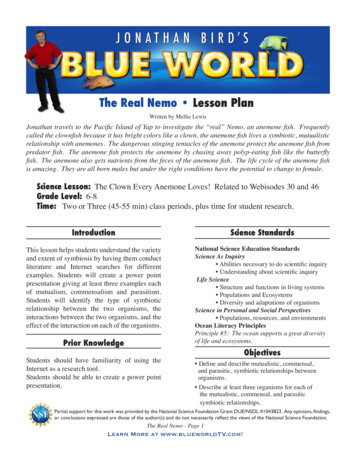
Transcription
The Real Nemo Lesson PlanWritten by Mellie LewisJonathan travels to the Pacific Island of Yap to investigate the “real” Nemo, an anemone fish. Frequentlycalled the clownfish because it has bright colors like a clown, the anemone fish lives a symbiotic, mutualisticrelationship with anemones. The dangerous stinging tentacles of the anemone protect the anemone fish frompredator fish. The anemone fish protects the anemone by chasing away polyp-eating fish like the butterflyfish. The anemone also gets nutrients from the feces of the anemone fish. The life cycle of the anemone fishis amazing. They are all born males but under the right conditions have the potential to change to female.Science Lesson: The Clown Every Anemone Loves! Related to Webisodes 30 and 46Grade Level: 6-8Time: Two or Three (45-55 min) class periods, plus time for student research.IntroductionScience StandardsThis lesson helps students understand the varietyand extent of symbiosis by having them conductliterature and Internet searches for differentexamples. Students will create a power pointpresentation giving at least three examples eachof mutualism, commensalism and parasitism.Students will identify the type of symbioticrelationship between the two organisms, theinteractions between the two organisms, and theeffect of the interaction on each of the organisms.National Science Education StandardsScience As Inquiry Abilities necessary to do scientific inquiry Understanding about scientific inquiryLife Science Structure and functions in living systems Populations and Ecosystems Diversity and adaptations of organismsScience in Personal and Social Perspectives Populations, resources, and environmentsOcean Literacy PrinciplesPrinciple #5: The ocean supports a great diversityof life and ecosystems.Prior KnowledgeStudents should have familiarity of using theInternet as a research tool.Students should be able to create a power pointpresentation.Objectives Define and describe mutualistic, commensal,and parasitic, symbiotic relationships betweenorganisms. Describe at least three organisms for each ofthe mutualistic, commensal, and parasiticsymbiotic relationships.Partial support for this work was provided by the National Science Foundation Grant DUE/NSDL #1043823. Any opinions, findings,or conclusions expressed are those of the author(s) and do not necessarily reflect the views of the National Science Foundation.The Real Nemo - Page 1Learn More at www.blueworldTV.com!
BackgroundSymbiosis means “living together.” Symbiotic relationships are very common in the ocean, especiallyamong animals living on coral reefs. There are threegeneral types of symbiosis: mutualism, commensalism, and parasitism. Based on the interaction betweenorganisms, symbiotic relationships are grouped intoone of these types.Mutualism is a mutually beneficial relationship inwhich both organisms benefit. Each individual provides an advantage to the other, enabling them to exploit each other and thereby enhance their chances ofsurvival. An example of a mutualistic relationship isthe cleaner fish that works with larger fish to removeparasites and diseased tissue from their scales, gills,or mouths. This cleaning may take place casually orat a cleaning station. The relationship may take placebetween species that are closely related, or more distantly related. One fish that act as cleaners when theyare young is a hogfish, and another cleaner fish is awrasse.Parasitism is a relationship that is beneficial for oneorganism and harmful for the other. Parasitic relationships are also common on the coral reef. The parasite will use the host’s nutrients or energy in orderto aid its own life, and slowly kill the host, or allowthe host to maintain its life in order to maintain theparasite’s life. An example of a parasitic relationshipis the Sacculina carcini, a barnacle that infests a hostcrab. This barnacle finds a hole in the exoskeleton ofthe crab, so microscopic hairs can penetrate the holeand the barnacle injects a few cells, and then appearsas a “slug” on the underside of the crab. The barnacleabsorbs nutrients from the crab’s blood, but does nottrigger any immune responses, so the crab continueswith its daily life. The female Sacculina lays her eggsin the crab’s brood pouch, and the instinct of the unsuspecting crab is to continue nurturing the contentsof the pouch, and eventually aid in the dispersal of thebarnacles eggs for future fertilization, which allowsthe parasite to continue on with its life cycle.Commensalism is defined as a symbiotic relationshipin which one organism benefits and the other is unaffected. Commensalistic relationships occur very oftenon the coral reef, many times for camouflage and forprotection against predators. This relationship is important for the organism that is being camouflaged,but does not aid in the life of the organism providingthe camouflage and does not harm it either. An example of commensalism is the relationship betweenthe Anemone crab and an anemone. The Anemonecrab lives in the protection of the anemone’s tentaclesand catches its food without ever leaving the safety ofthe tentacles. However, the crab does not provide anyservice to the anemone.The Real Nemo - Page 2Anemone crab in anemone.Learn More at www.blueworldTV.com!
Helpful VocabularySymbiotic:A relationship in which two organisms exist in close association, which may or may notbenefit both organisms.Mutualism:A relationship between organisms in which both organisms benefit.Commensalism:A relationship between organisms in which one organism benefits and the other is notaffected.Parasitism:A relationship between organisms in which one organism benefits and the other may beharmed.Lesson ProcedureMaterials: Computers with Internet access Reference books Dive magazines Student handout, “Symbiotic Relationship Table”Lesson:Introduce the lesson by asking students to definesymbiosis.Show the Jonathan Bird’s Blue World webisodes,Real Nemo and Symbiosis. These two webisodes dealwith the three kinds of symbiotic relationships.Review the background information with students.Explain to students that their task will be to researchthe three kinds of symbiotic relationships found inthe ocean and create a Powerpoint presentation toshare with the class. The Powerpoint must give atleast three examples each of mutualism, commensalism and parasitism. In the presentation students willidentify the type of symbiotic relationship betweenthe two organisms, the interactions between the twoorganisms, and the effect of the interaction on eachof the organisms. Students will complete the “Symbiotic Relationships Table” and use it as a storyboardfor their Powerpoint presentations.The Real Nemo - Page 3Learn More at www.blueworldTV.com!
Follow Up Questions: Why would an organisms want to be in amutualistic relationship? How does it benefit an organism to be parasitic? What are the characteristics of a “good” parasite(meaning a parasite that is very effective at beingparasitic)?Sea turtle with “hitch-hiker” barnacles-a good example ofcommensalism. Photo by Jonathan Bird.Going Further: What forms of symbiotic relationships are foundin streams, lakes, rivers, or the deep ocean?False-clown Anemonefish in its host anemone-classic exampleof mutualism. Photo by Jonathan Bird.An isopod on a butterflyfish-common form of parasitism in theocean. Photo by Jonathan Bird.The Real Nemo - Page 4Learn More at www.blueworldTV.com!
Symbiotic Relationship TableOrganismsSymbiotic RelationshipInteractions BetweenOrganismsThe Real Nemo - Page 5Learn More at www.blueworldTV.com!Effect of the Interactionon Each Organism
Answers to Follow Up Questions: Why would an organisms want to be in a mutualistic relationship?A mutualistic relationship makes life easier for both participants. By cooperating, two organisms get somethingout of their relationship. For exmaple, a flower gets its pollen dispersed by a bee and the bee gets nectar tomake honey from the flower. Everyone benefits. How does it benefit an organism to be parasitic?The parasite gets a “free ride” from another organism with minimal work from itself. Sort of like getting yourolder brother or sister to do your homework! What are the characteristics of a “good” parasite (meaning a parasite that is very effective at beingparasitic)?A “good” parasite gets a free ride without harming its host. For example, if a parasite makes its host getsick and die, the “free ride” ends. So a good parasite causes minimal discomfort or danger to the host whileretaining its benefits.The Real Nemo - Page 6Learn More at www.blueworldTV.com!
Symbiosis means “living together.” Symbiotic rela-tionships are very common in the ocean, especially among animals living on coral reefs. There are three general types of symbiosis: mutualism, commensal-ism, and parasitism. Based on the interaction between organisms, sym
